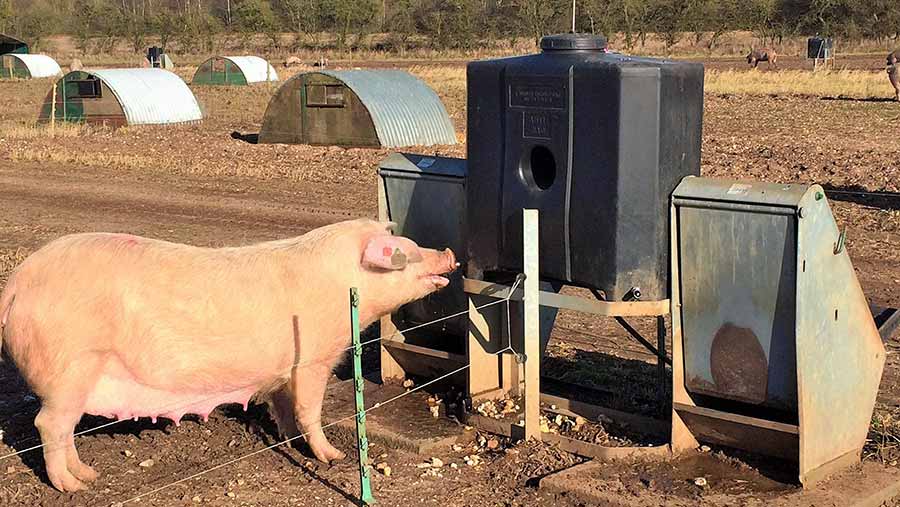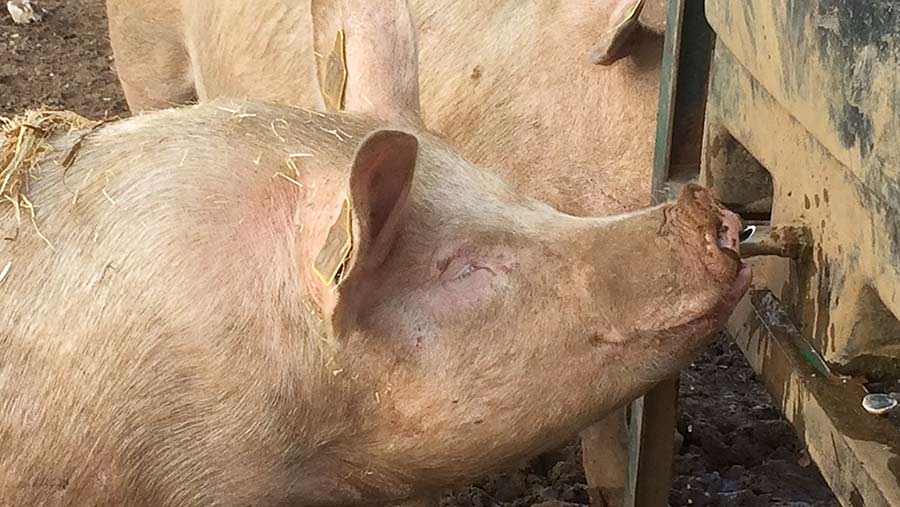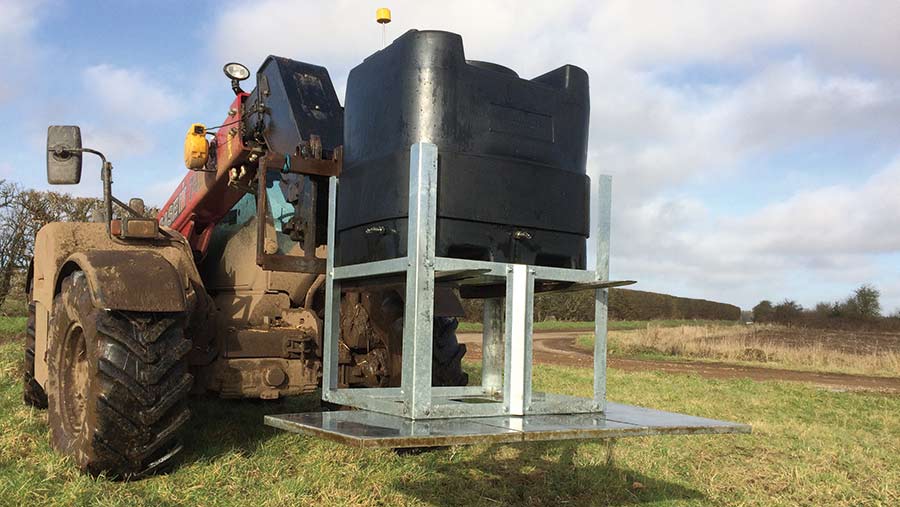How Norfolk pig farmers cut water use by 50%

Moulded plastic tanks with nipple drinkers have transformed water quality and brought water and labour savings for a Norfolk outdoor pig operation.
The team at LSB Pigs, based at East Rudham, Fakenham, has found the improved performance to be worth roughly 0.5kg to weaner weight, while water use has been cut by 50% compared with the wallow troughs the farm used previously.
Further benefits are time saved in emptying troughs, which was a regular job as they quickly became contaminated by birds or full of earth and stones.
Despite the pigs drinking more from the tanks, they use less water overall because of reduced wastage.
See also: Tips on improving water quality for pigs
LSB Pigs, Norfolk
- 1,550 sows on 62ha of rented land
- Light free-draining soil
- LSB Coxford (1994) runs 1,000 sows on 42ha of land
- LSB High House (2017) runs 550 sows on 20ha
- Producing 28-day old weaners for BQP Tulip
- Developing and selling water tanks through Contented Products
- Seven full-time staff plus part-time help
“We ran a year-long piglet weight trial in conjunction with the AHDB and that showed an improved piglet weaning weight when the lactating sows drank from tanks,” explains Rob McGregor, manager at LSB Pigs.

In some designs feeders are attached to the base plate and combined with water tanks
“Consumption was also recorded and the tank-supplied sows in farrowing drank on average 30% more water but in hot weather they were drinking even more, up to double the trough-supplied mothers.”
Eight benefits of the tank system
- Cleanliness: Water is kept clean and hygienic, protected from contamination by pigs, birds and rodents. Algae and cyanobacteria can’t grow in the tank because sunlight can’t penetrate the plastic and an antibacterial additive in the plastic prevents mould and biofilm.
- Temperature: Tanks maintain a four-degree temperature differential, supplying cooler water in summer and preventing frozen water in winter. In summer, temperatures stay below 20 degrees, promoting intake in hot weather.
- Back-up storage: Large tanks supply two to three days of backup water supply. Tanks are 250 litres and 500 litres (20 dry sows drinking 8 litres/day for three days = 480 litres).
- Design: Moving parts are designed to be positioned away from livestock to avoid damage, while the steel frame’s weight and strength prevent shunting into electric fencing.
- Water gauge: Tanks have yellow beacons attached to a rod and float indicating water level.
- Sustainability: Uses 50% less water through reliability, zero evaporation, zero displacement and no need to empty the system.
- Automatic fill: Saves on bowsering when being relocated as tanks can be filled and then moved while pipework is moved.
- Reduced maintenance: Mud and stones don’t need unblocking from ball floats as with troughs. Troughs also need regular emptying to be cleaned.
Tank Design
The tanks are moulded plastic mounted on a steel frame on a base to increase stability.
An antibacterial silver-based additive is mixed with the plastic granules when the tank is moulded.
This offers protection again bacteria, biofilm, fungi and mould, explains Mr McGregor.

Pigs bite or press the nipple with nose or tongue to make the water flow
Farrow feeders, which have largely replaced on-floor feeding in the outdoor pig industry, can be mounted to the tanks to offer two feeders and a tank for farrowing sows.
Dry sow tanks have a capacity of 500 litres and farrowing sow tanks hold 250 litres.
One downside to using tanks is that there is no exposed water, so Mr McGregor stresses that it’s vital to establish wallows in the warmer spring and summer periods.
Drinking nipples run parallel to the floor at the bottom of the tank. Trial work has found that pigs drink in three ways:
- Pushing the nipple with their nose and catching water with their mouth
- Biting the nipple straight on and releasing water with their tongue
- Biting the nipple at the side and using the tongue to release the water
Early development
Mr McGregor says that, after a long period of trial and error, the team eventually found a design that worked.
The team first used steel water tanks, bought secondhand, to replace open troughs in the gilt growing paddocks.
Gilt performance and wellbeing improved, but the tanks were still not ideal, so they opted to experiment with plastic IBC (intermediate bulk container) tanks.
Clear tanks were tried at first but they were transparent and thin, leading to warm water in summer and frost problems in winter, Mr McGregor explains.
They also allowed sunlight to penetrate, encouraging algae and bacteria.

Sturdy steel frames allow the tanks to be moved in one piece by forklift
“The process took a while because each design iteration needed 12 months to see whether it got caught out in summer or winter,” he says.
A breakthrough came when British Quality Pigs (BQP) developed long trough feeders and eventually made them compulsory. A feeding station was built using two feeders, each with its own base plate and linked with a centrally mounted tank.
By this time the LSB team had settled on bespoke black tanks which were moulded by Contented Products. The tanks became commercially available in 2014 and sales have grown annually since.
Water tanks are supplied using the same alkathene plastic piping as the troughs were. All water is from borehole water supplies.
Approximate costs for tanks
Individual Farrowing paddocks (one tank per two sows)
- 250 litre tank £68
- 250 litre tank on stand £115
Dry sow and service paddocks (one tank per 30 sows max)
- 500 litre tank £95
- 500 litre tank on stand £195
- 1,000 litre tank (large gilt groups and growing pigs) £200
Outdoor system
LSB Pigs runs a total of 1,550 sows on rented land, rearing a current average of 26.5 pigs a sow a year in nomadic units that move every two years, fitting into the landlord’s arable rotation of barley and sugar beet.
Pigs move into barley stubbles or sometimes a grass crop if possible. Sugar beet then follows the pigs.
Replacement gilts are homebred from a breeding herd of 160 Danbred Landrace sows crossed to a PIC Red Duroc Boar by AI. Every three weeks 55 gilt replacements are selected for both farms.
Gilts are served at 240 days and farrow at about 365 days. PIC337 boar semen is used on commercial sows.
Effect on pig performance: AHDB Trials
Trials at LSB Coxford recorded batches from March 2013 to July 2013, finding that:
- Average daily water requirement on tanks and nipples was 30% lower than on wallow troughs (8.66 litres a sow/day versus 12.44 litres a sow/day).
- Three out of four batches were, on average, 0.53kg heavier in the tank and nipple system, with only one batch being 0.32kg heavier in the trough system.
- Lactating sows drank almost twice the amount. Intake went from 27.3 litres to 53.1 litres a sow/day when switching from troughs to tanks over a 16-batch study.
